
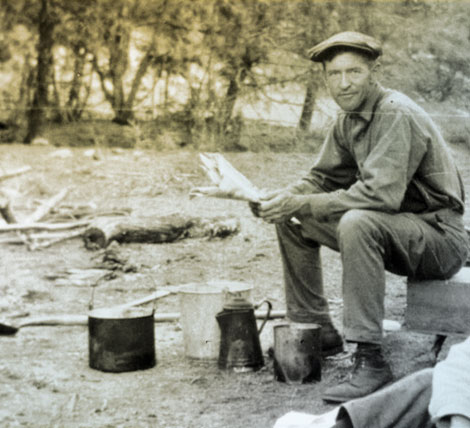 William H. Bartlett came to Arizona in 1888 at the age of nine. He later helped organize the Verde River Irrigation and Power District. For 10 years, he served as the District's field engineer and for 33 years as secretary. He is credited with discovering the dam site while surveying the Verde River. His knowledge of the river and its surrounding topography was unsurpassed. Bartlett lived and worked in the Phoenix area until he died in June 1966. (Courtesy of Slat River Project)
William H. Bartlett came to Arizona in 1888 at the age of nine. He later helped organize the Verde River Irrigation and Power District. For 10 years, he served as the District's field engineer and for 33 years as secretary. He is credited with discovering the dam site while surveying the Verde River. His knowledge of the river and its surrounding topography was unsurpassed. Bartlett lived and worked in the Phoenix area until he died in June 1966. (Courtesy of Slat River Project)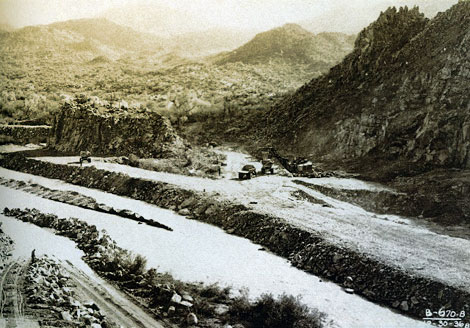 Construction beginning on abutment for the dam, 1936. (Courtesy of Salt River Project)
Construction beginning on abutment for the dam, 1936. (Courtesy of Salt River Project)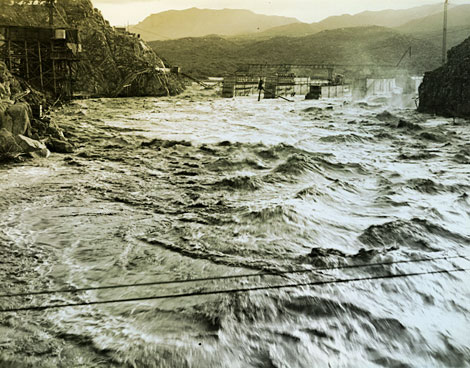 During the morning of March 4, 1938, the Verde River rampaged through the construction site. This photograph was taken around 9:00 AM. The river was discharging about 79,000 feet per second. (Courtesy of Salt River Project)
During the morning of March 4, 1938, the Verde River rampaged through the construction site. This photograph was taken around 9:00 AM. The river was discharging about 79,000 feet per second. (Courtesy of Salt River Project)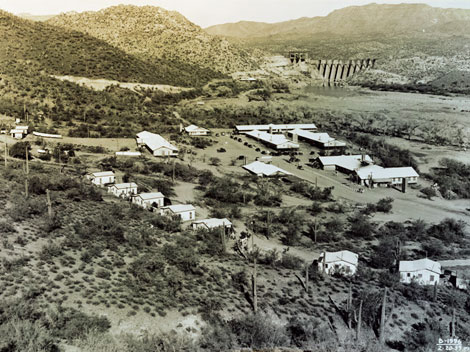 The photograph shows the construction camp where Reclamation staff and the contractor's work force lived. Essentially a small town, the camp had a school, post office, infirmary, mess hall, barracks, married housing quarters, workshops, and offices. (Courtesy of Salt River Project)
The photograph shows the construction camp where Reclamation staff and the contractor's work force lived. Essentially a small town, the camp had a school, post office, infirmary, mess hall, barracks, married housing quarters, workshops, and offices. (Courtesy of Salt River Project)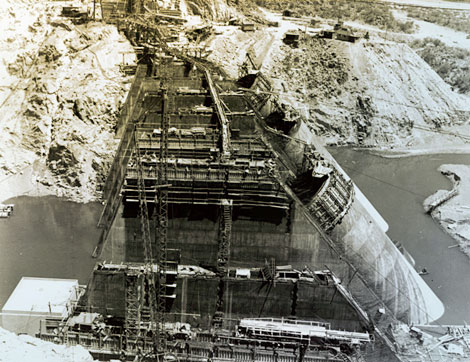 Construction was well underway by 1938. This photograph shows on-going construction of the multiple arches. Low heat cement was used in the concrete to speed up construction, and a system of fog-spray nozzles continuously cooled the concrete by evaporation. (Courtesy of Salt River Project)
Construction was well underway by 1938. This photograph shows on-going construction of the multiple arches. Low heat cement was used in the concrete to speed up construction, and a system of fog-spray nozzles continuously cooled the concrete by evaporation. (Courtesy of Salt River Project)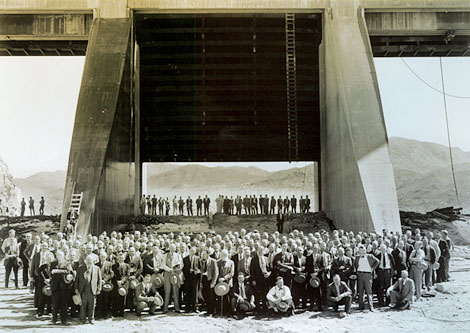 Reclamation and contractor personnel pose beneath one of three Stoney gates in this 1939 photograph. Each Stoney gate was 50 feet by 50 feet, weighed 200 tons, and could be raised about 4 inches per minute. (Courtesy of Salt River Project)
Reclamation and contractor personnel pose beneath one of three Stoney gates in this 1939 photograph. Each Stoney gate was 50 feet by 50 feet, weighed 200 tons, and could be raised about 4 inches per minute. (Courtesy of Salt River Project)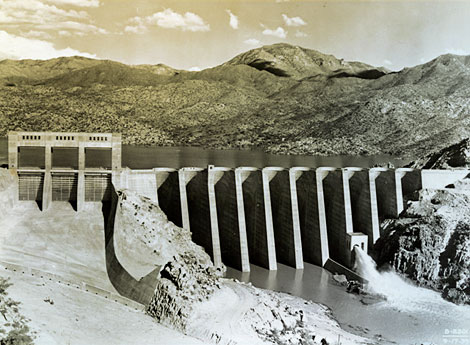 Bartlett Dam was completed May 9, 1939 in less than 1,000 days and $270,000 under budget. (Courtesy of Salt River Project)
Bartlett Dam was completed May 9, 1939 in less than 1,000 days and $270,000 under budget. (Courtesy of Salt River Project)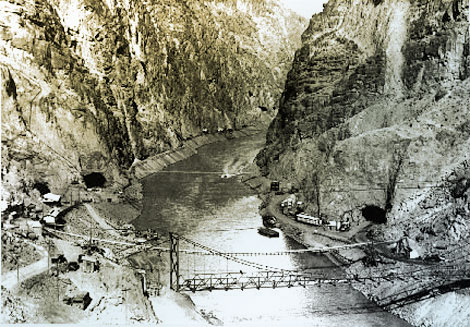 This view of the Black Canyon damsite looking downstream shows preliminary work preparing the site for construction. The two tunnels can be seen that will divert water around the construction site. (Reclamation photograph)
This view of the Black Canyon damsite looking downstream shows preliminary work preparing the site for construction. The two tunnels can be seen that will divert water around the construction site. (Reclamation photograph)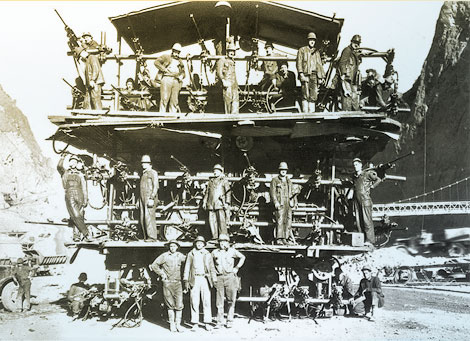 This special drilling rig was designed to speed up the drilling of tunnels. (Reclamation photograph)
This special drilling rig was designed to speed up the drilling of tunnels. (Reclamation photograph)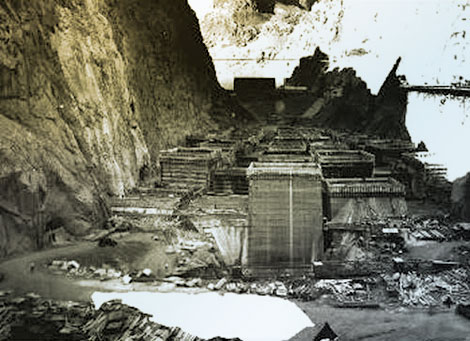 The foundation for the huge dam begins to take shape as the first of 3,250,335 cubic yards of concrete is poured. (Reclamation photograph)
The foundation for the huge dam begins to take shape as the first of 3,250,335 cubic yards of concrete is poured. (Reclamation photograph)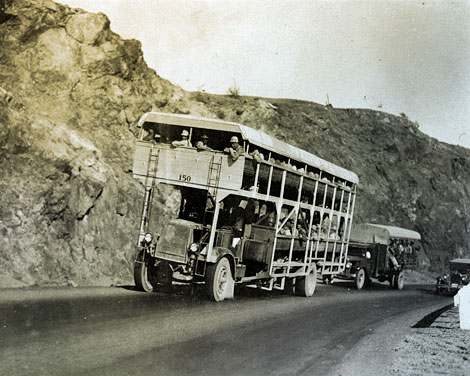 The massive size of the dam construction project called for special equipment. In order to get the thousands of workers to the damsite, vehicles capable of carrying from 100 to 150 men were used. (Reclamation photograph)
The massive size of the dam construction project called for special equipment. In order to get the thousands of workers to the damsite, vehicles capable of carrying from 100 to 150 men were used. (Reclamation photograph)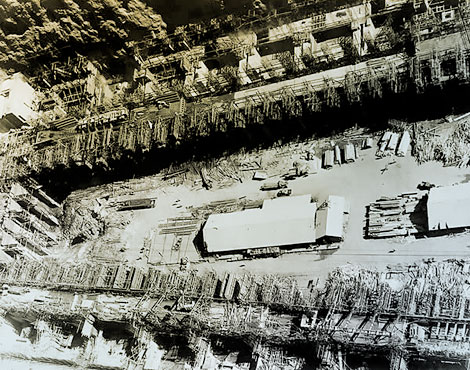 A bird's eye view of the power house under construction. (Reclamation photograph)
A bird's eye view of the power house under construction. (Reclamation photograph)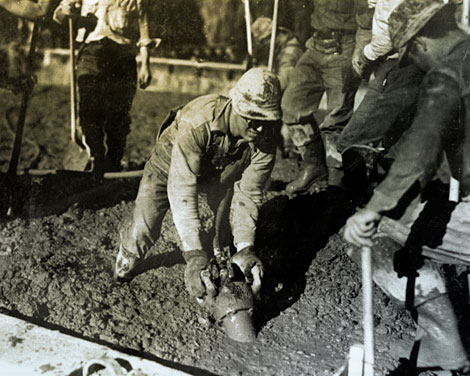 When concrete is poured, it is important to eliminate air pockets. Here workers use a vibrator to settle the concrete and remove air pockets. (Reclamation photograph)
When concrete is poured, it is important to eliminate air pockets. Here workers use a vibrator to settle the concrete and remove air pockets. (Reclamation photograph)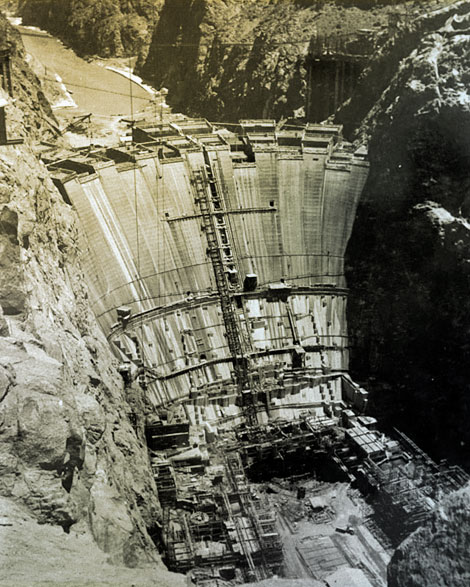 View of the downstream face of the dam with the powerhouse under construction. (Reclamation photograph)
View of the downstream face of the dam with the powerhouse under construction. (Reclamation photograph)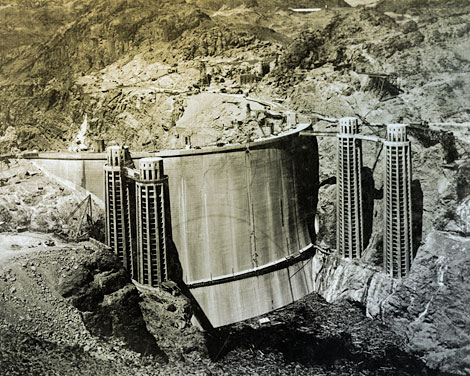 A view of the upstream face of the dam near completion of construction. The four intake towers are visible through which water is sent via the penstocks to the generators. (Reclamation photograph)
A view of the upstream face of the dam near completion of construction. The four intake towers are visible through which water is sent via the penstocks to the generators. (Reclamation photograph)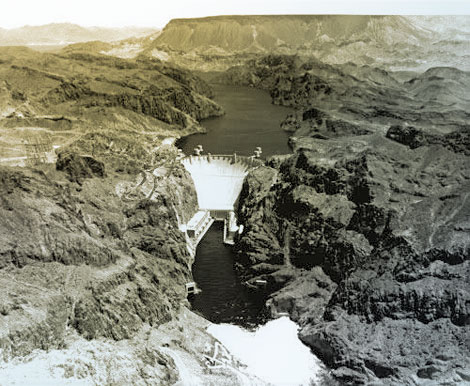 The finished dam looking upstream with the power plant at the base of the dam. (Reclamation photograph)
The finished dam looking upstream with the power plant at the base of the dam. (Reclamation photograph)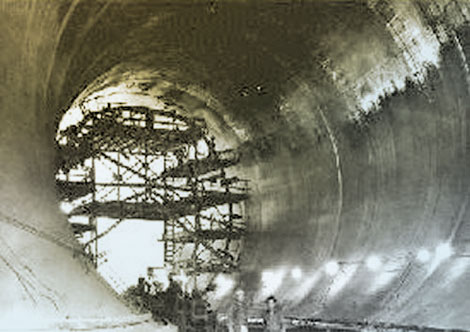 Four 50 ft. diameter diversion tunnels, two on each side of the canyon, were drilled through rock to carry water around the construction site. Upon completion, each tunnel was lined with 3 feet of concrete. (Reclamation photograph)
Four 50 ft. diameter diversion tunnels, two on each side of the canyon, were drilled through rock to carry water around the construction site. Upon completion, each tunnel was lined with 3 feet of concrete. (Reclamation photograph)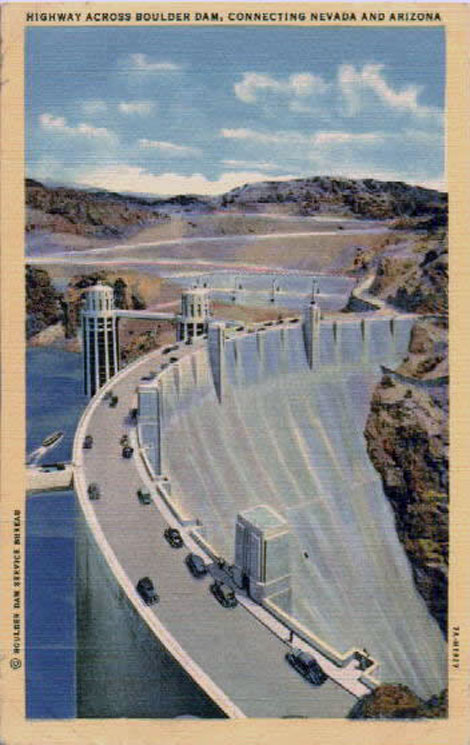 Postcard view of the completed dam, a popular tourist attraction.
Postcard view of the completed dam, a popular tourist attraction.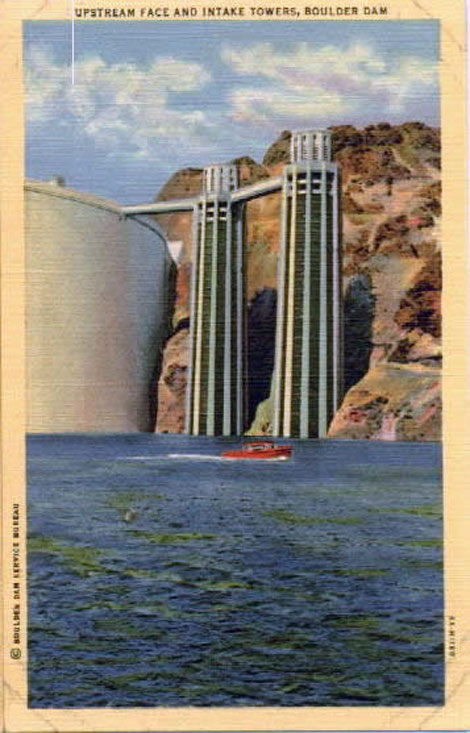 Postcard view of the completed dam, a popular tourist attraction.
Postcard view of the completed dam, a popular tourist attraction.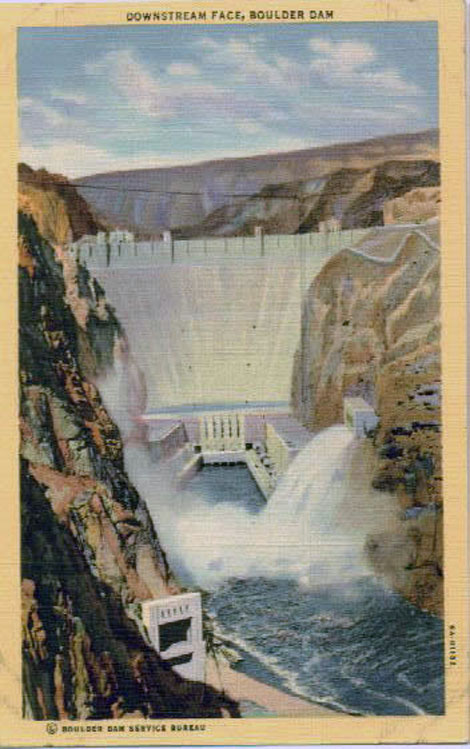 Postcard view of the completed dam, a popular tourist attraction.
Postcard view of the completed dam, a popular tourist attraction.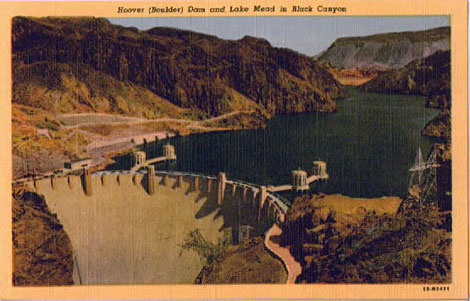 Postcard view of the completed dam, a popular tourist attraction.
Postcard view of the completed dam, a popular tourist attraction. 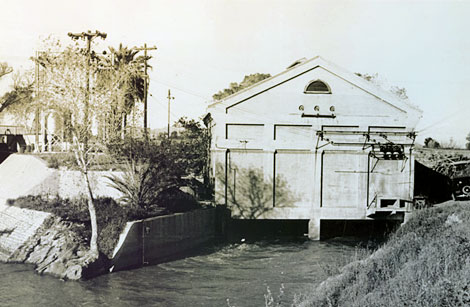 Arizona Falls, located on the Arizona Canal, was the first of four hydropower plants built on SRP canals. These plants generated electricity to supplement that produced by Roosevelt Dam. (Courtesy of Salt River Project)
Arizona Falls, located on the Arizona Canal, was the first of four hydropower plants built on SRP canals. These plants generated electricity to supplement that produced by Roosevelt Dam. (Courtesy of Salt River Project)
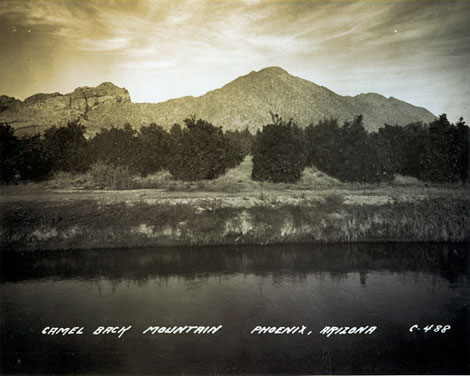 This citrus grove is located along the Arizona Canal from which it receives its irrigation water (Camelback Mountain is in the background). For many years, providing water for irrigation was the primary goal of the Salt River Valley Water Users Association. (Courtesy of Salt River Project)
This citrus grove is located along the Arizona Canal from which it receives its irrigation water (Camelback Mountain is in the background). For many years, providing water for irrigation was the primary goal of the Salt River Valley Water Users Association. (Courtesy of Salt River Project)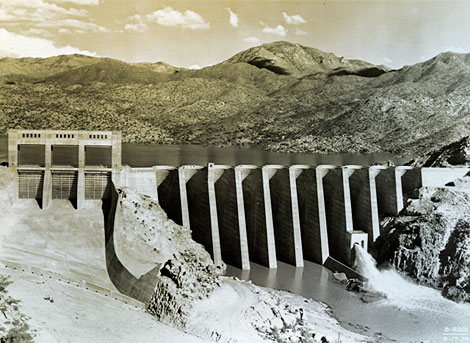 Bartlett Dam, located on the Verde River, was completed in 1939 by the Bureau of Reclamation. It was designed to store water for Salt River Valley farmers and did not produce electricity. (Courtesy of Salt River Project)
Bartlett Dam, located on the Verde River, was completed in 1939 by the Bureau of Reclamation. It was designed to store water for Salt River Valley farmers and did not produce electricity. (Courtesy of Salt River Project)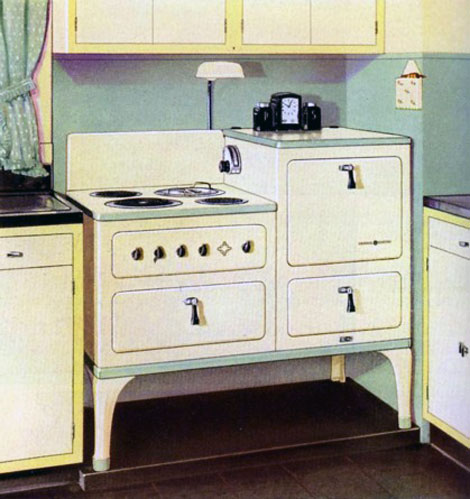 By the 1930s, electric appliances such as cooking ranges and even dishwashers were becoming increasingly common in many urban areas such as metropolitan Phoenix. More power was needed as the demand for electric appliances, tools, radios, and other items grew. Meeting the needs of farmers for irrigation water and consumers for electricity was a delicate balancing act for the Salt River Valley Water Users Association.
By the 1930s, electric appliances such as cooking ranges and even dishwashers were becoming increasingly common in many urban areas such as metropolitan Phoenix. More power was needed as the demand for electric appliances, tools, radios, and other items grew. Meeting the needs of farmers for irrigation water and consumers for electricity was a delicate balancing act for the Salt River Valley Water Users Association. By the 1930s, electric appliances such as cooking ranges and even dishwashers were becoming increasingly common in many urban areas such as metropolitan Phoenix. More power was needed as the demand for electric appliances, tools, radios, and other items grew. Meeting the needs of farmers for irrigation water and consumers for electricity was a delicate balancing act for the Salt River Valley Water Users Association.
By the 1930s, electric appliances such as cooking ranges and even dishwashers were becoming increasingly common in many urban areas such as metropolitan Phoenix. More power was needed as the demand for electric appliances, tools, radios, and other items grew. Meeting the needs of farmers for irrigation water and consumers for electricity was a delicate balancing act for the Salt River Valley Water Users Association. 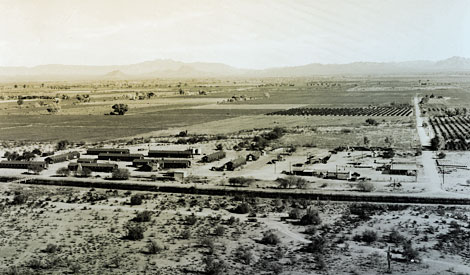 A view of the Bureau of Reclamation CCC Camp BR-19 in Tempe. The canal in the foreground is the Cross Cut Canal that links the Arizona Canal and Grand Canal. (Reclamation photograph)
A view of the Bureau of Reclamation CCC Camp BR-19 in Tempe. The canal in the foreground is the Cross Cut Canal that links the Arizona Canal and Grand Canal. (Reclamation photograph)
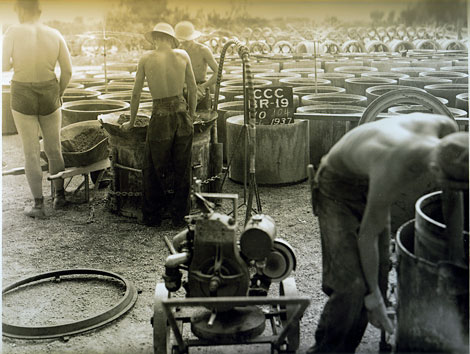 Camp BR-19 contained a number of facilities to support its work on rehabilitating SRP canals and laterals. In this view, CCC workers are casting concrete pipe for use in piping open laterals. They were able to cast concrete pipe in different diameters to meet a variety of piping needs. (Reclamation photograph)
Camp BR-19 contained a number of facilities to support its work on rehabilitating SRP canals and laterals. In this view, CCC workers are casting concrete pipe for use in piping open laterals. They were able to cast concrete pipe in different diameters to meet a variety of piping needs. (Reclamation photograph)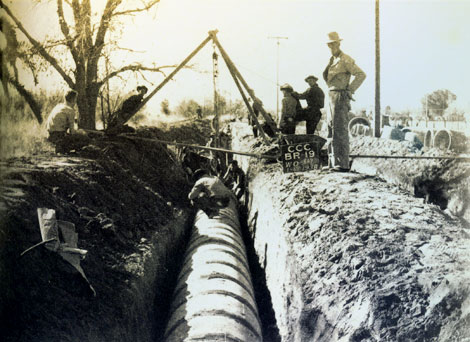 In this 1938 photo, a CCC work crew from Camp BR-19 installs a 30-inch diameter pipe along a lateral known as "Little Maricopa" west of Central Avenue in Phoenix. (Reclamation photograph)
In this 1938 photo, a CCC work crew from Camp BR-19 installs a 30-inch diameter pipe along a lateral known as "Little Maricopa" west of Central Avenue in Phoenix. (Reclamation photograph)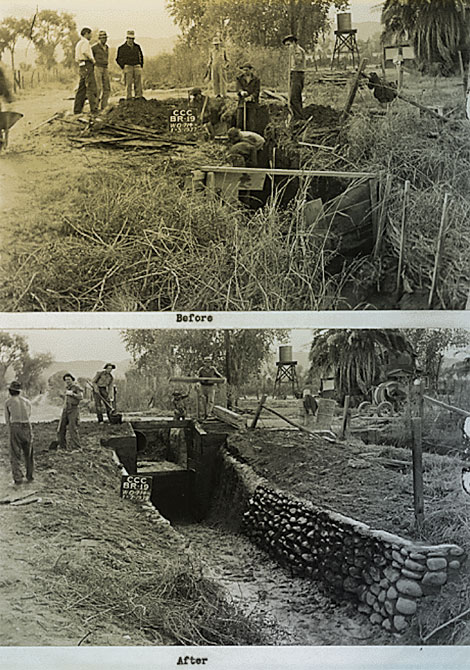 This photograph shows the end result of a CCC work crew's rehabilitation of an old, wooden check structure with a new concrete structure. These crews replaced many deteriorated wooden structures with concrete structures. (Reclamation photograph)
This photograph shows the end result of a CCC work crew's rehabilitation of an old, wooden check structure with a new concrete structure. These crews replaced many deteriorated wooden structures with concrete structures. (Reclamation photograph)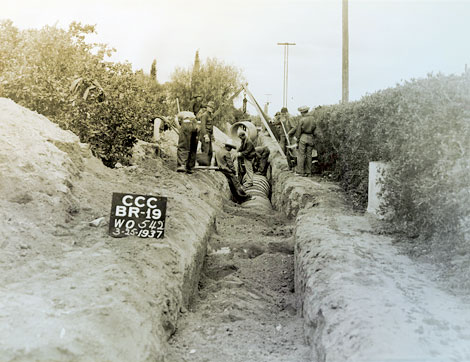 Another open lateral is being piped by a CCC work crew in this 1937 photograph. A large part of the SRP infrastructure was upgraded by CCC crews. (Reclamation photograph)
Another open lateral is being piped by a CCC work crew in this 1937 photograph. A large part of the SRP infrastructure was upgraded by CCC crews. (Reclamation photograph)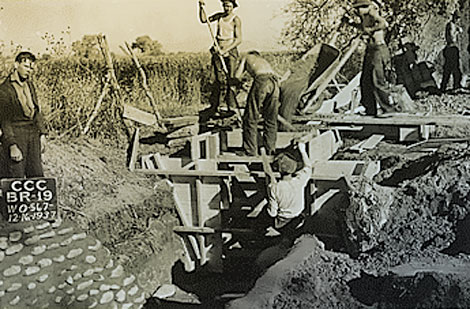 This 1937 photograph shows a CCC work crew building a form to replace an old wooden check structure with a concrete structure. Note the new cobble and concrete wall to reduce erosion of the lateral. (Reclamation photograph)
This 1937 photograph shows a CCC work crew building a form to replace an old wooden check structure with a concrete structure. Note the new cobble and concrete wall to reduce erosion of the lateral. (Reclamation photograph)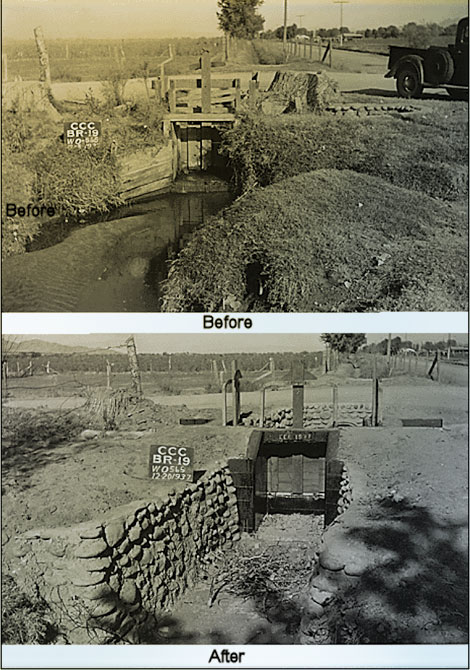 Here is another example of a four-way control structure that was replaced with a concrete structure, although the new control gate is made of wood. Eventually these gates were replaced with metal gates that were raised and lowered by means of a hand-turned screw. (Reclamation photograph)
Here is another example of a four-way control structure that was replaced with a concrete structure, although the new control gate is made of wood. Eventually these gates were replaced with metal gates that were raised and lowered by means of a hand-turned screw. (Reclamation photograph)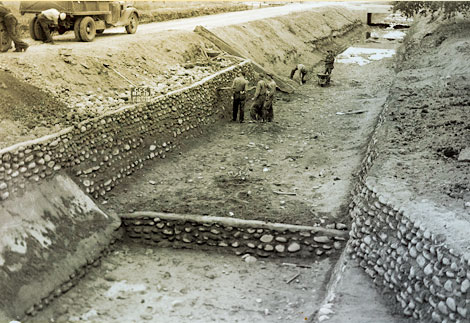 Some canal walls were stabilized with cobbles set in concrete to reduce erosion. (Reclamation photograph)
Some canal walls were stabilized with cobbles set in concrete to reduce erosion. (Reclamation photograph)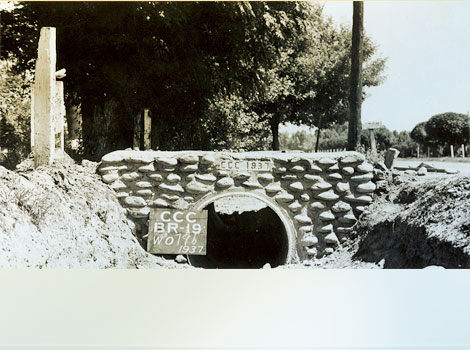 BR-19 constructed culvert, 1937. (Reclamation photograph)
BR-19 constructed culvert, 1937. (Reclamation photograph) BR-19 Pipe Yard.
BR-19 Pipe Yard.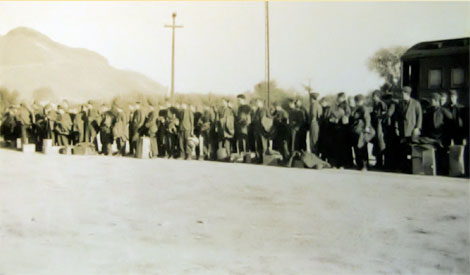 CCC enrollees of Company 805 arrive in Tempe, AZ, October 23, 1935.
CCC enrollees of Company 805 arrive in Tempe, AZ, October 23, 1935.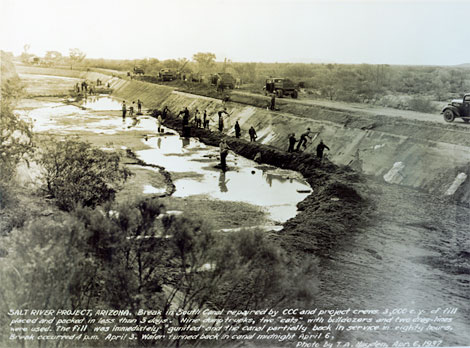 Enrollees conducting emergency repairs on the Southern Canal.
Enrollees conducting emergency repairs on the Southern Canal. Wooden Canal Headgate.
Wooden Canal Headgate. 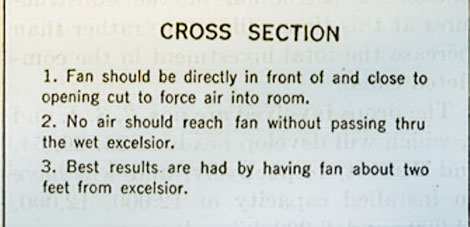 Air cooler instructions.
Air cooler instructions.
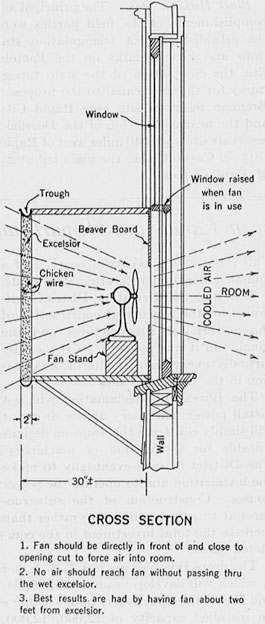 Air cooler diagram.
Air cooler diagram.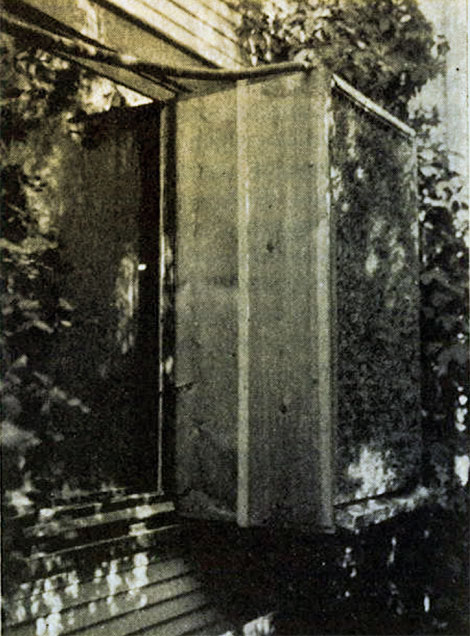 Air conditioner.
Air conditioner.[ Return to Top ]


 William H. Bartlett came to Arizona in 1888 at the age of nine. He later helped organize the Verde River Irrigation and Power District. For 10 years, he served as the District's field engineer and for 33 years as secretary. He is credited with discovering the dam site while surveying the Verde River. His knowledge of the river and its surrounding topography was unsurpassed. Bartlett lived and worked in the Phoenix area until he died in June 1966. (Courtesy of Slat River Project)
William H. Bartlett came to Arizona in 1888 at the age of nine. He later helped organize the Verde River Irrigation and Power District. For 10 years, he served as the District's field engineer and for 33 years as secretary. He is credited with discovering the dam site while surveying the Verde River. His knowledge of the river and its surrounding topography was unsurpassed. Bartlett lived and worked in the Phoenix area until he died in June 1966. (Courtesy of Slat River Project) Construction beginning on abutment for the dam, 1936. (Courtesy of Salt River Project)
Construction beginning on abutment for the dam, 1936. (Courtesy of Salt River Project) During the morning of March 4, 1938, the Verde River rampaged through the construction site. This photograph was taken around 9:00 AM. The river was discharging about 79,000 feet per second. (Courtesy of Salt River Project)
During the morning of March 4, 1938, the Verde River rampaged through the construction site. This photograph was taken around 9:00 AM. The river was discharging about 79,000 feet per second. (Courtesy of Salt River Project) The photograph shows the construction camp where Reclamation staff and the contractor's work force lived. Essentially a small town, the camp had a school, post office, infirmary, mess hall, barracks, married housing quarters, workshops, and offices. (Courtesy of Salt River Project)
The photograph shows the construction camp where Reclamation staff and the contractor's work force lived. Essentially a small town, the camp had a school, post office, infirmary, mess hall, barracks, married housing quarters, workshops, and offices. (Courtesy of Salt River Project) Construction was well underway by 1938. This photograph shows on-going construction of the multiple arches. Low heat cement was used in the concrete to speed up construction, and a system of fog-spray nozzles continuously cooled the concrete by evaporation. (Courtesy of Salt River Project)
Construction was well underway by 1938. This photograph shows on-going construction of the multiple arches. Low heat cement was used in the concrete to speed up construction, and a system of fog-spray nozzles continuously cooled the concrete by evaporation. (Courtesy of Salt River Project) Reclamation and contractor personnel pose beneath one of three Stoney gates in this 1939 photograph. Each Stoney gate was 50 feet by 50 feet, weighed 200 tons, and could be raised about 4 inches per minute. (Courtesy of Salt River Project)
Reclamation and contractor personnel pose beneath one of three Stoney gates in this 1939 photograph. Each Stoney gate was 50 feet by 50 feet, weighed 200 tons, and could be raised about 4 inches per minute. (Courtesy of Salt River Project) Bartlett Dam was completed May 9, 1939 in less than 1,000 days and $270,000 under budget. (Courtesy of Salt River Project)
Bartlett Dam was completed May 9, 1939 in less than 1,000 days and $270,000 under budget. (Courtesy of Salt River Project) This view of the Black Canyon damsite looking downstream shows preliminary work preparing the site for construction. The two tunnels can be seen that will divert water around the construction site. (Reclamation photograph)
This view of the Black Canyon damsite looking downstream shows preliminary work preparing the site for construction. The two tunnels can be seen that will divert water around the construction site. (Reclamation photograph) This special drilling rig was designed to speed up the drilling of tunnels. (Reclamation photograph)
This special drilling rig was designed to speed up the drilling of tunnels. (Reclamation photograph) The foundation for the huge dam begins to take shape as the first of 3,250,335 cubic yards of concrete is poured. (Reclamation photograph)
The foundation for the huge dam begins to take shape as the first of 3,250,335 cubic yards of concrete is poured. (Reclamation photograph) The massive size of the dam construction project called for special equipment. In order to get the thousands of workers to the damsite, vehicles capable of carrying from 100 to 150 men were used. (Reclamation photograph)
The massive size of the dam construction project called for special equipment. In order to get the thousands of workers to the damsite, vehicles capable of carrying from 100 to 150 men were used. (Reclamation photograph) A bird's eye view of the power house under construction. (Reclamation photograph)
A bird's eye view of the power house under construction. (Reclamation photograph) When concrete is poured, it is important to eliminate air pockets. Here workers use a vibrator to settle the concrete and remove air pockets. (Reclamation photograph)
When concrete is poured, it is important to eliminate air pockets. Here workers use a vibrator to settle the concrete and remove air pockets. (Reclamation photograph) View of the downstream face of the dam with the powerhouse under construction. (Reclamation photograph)
View of the downstream face of the dam with the powerhouse under construction. (Reclamation photograph) A view of the upstream face of the dam near completion of construction. The four intake towers are visible through which water is sent via the penstocks to the generators. (Reclamation photograph)
A view of the upstream face of the dam near completion of construction. The four intake towers are visible through which water is sent via the penstocks to the generators. (Reclamation photograph) The finished dam looking upstream with the power plant at the base of the dam. (Reclamation photograph)
The finished dam looking upstream with the power plant at the base of the dam. (Reclamation photograph) Four 50 ft. diameter diversion tunnels, two on each side of the canyon, were drilled through rock to carry water around the construction site. Upon completion, each tunnel was lined with 3 feet of concrete. (Reclamation photograph)
Four 50 ft. diameter diversion tunnels, two on each side of the canyon, were drilled through rock to carry water around the construction site. Upon completion, each tunnel was lined with 3 feet of concrete. (Reclamation photograph) Postcard view of the completed dam, a popular tourist attraction.
Postcard view of the completed dam, a popular tourist attraction. Postcard view of the completed dam, a popular tourist attraction.
Postcard view of the completed dam, a popular tourist attraction. Postcard view of the completed dam, a popular tourist attraction.
Postcard view of the completed dam, a popular tourist attraction. Postcard view of the completed dam, a popular tourist attraction.
Postcard view of the completed dam, a popular tourist attraction. Arizona Falls, located on the Arizona Canal, was the first of four hydropower plants built on SRP canals. These plants generated electricity to supplement that produced by Roosevelt Dam. (Courtesy of Salt River Project)
Arizona Falls, located on the Arizona Canal, was the first of four hydropower plants built on SRP canals. These plants generated electricity to supplement that produced by Roosevelt Dam. (Courtesy of Salt River Project) This citrus grove is located along the Arizona Canal from which it receives its irrigation water (Camelback Mountain is in the background). For many years, providing water for irrigation was the primary goal of the Salt River Valley Water Users Association. (Courtesy of Salt River Project)
This citrus grove is located along the Arizona Canal from which it receives its irrigation water (Camelback Mountain is in the background). For many years, providing water for irrigation was the primary goal of the Salt River Valley Water Users Association. (Courtesy of Salt River Project) Bartlett Dam, located on the Verde River, was completed in 1939 by the Bureau of Reclamation. It was designed to store water for Salt River Valley farmers and did not produce electricity. (Courtesy of Salt River Project)
Bartlett Dam, located on the Verde River, was completed in 1939 by the Bureau of Reclamation. It was designed to store water for Salt River Valley farmers and did not produce electricity. (Courtesy of Salt River Project) By the 1930s, electric appliances such as cooking ranges and even dishwashers were becoming increasingly common in many urban areas such as metropolitan Phoenix. More power was needed as the demand for electric appliances, tools, radios, and other items grew. Meeting the needs of farmers for irrigation water and consumers for electricity was a delicate balancing act for the Salt River Valley Water Users Association.
By the 1930s, electric appliances such as cooking ranges and even dishwashers were becoming increasingly common in many urban areas such as metropolitan Phoenix. More power was needed as the demand for electric appliances, tools, radios, and other items grew. Meeting the needs of farmers for irrigation water and consumers for electricity was a delicate balancing act for the Salt River Valley Water Users Association. By the 1930s, electric appliances such as cooking ranges and even dishwashers were becoming increasingly common in many urban areas such as metropolitan Phoenix. More power was needed as the demand for electric appliances, tools, radios, and other items grew. Meeting the needs of farmers for irrigation water and consumers for electricity was a delicate balancing act for the Salt River Valley Water Users Association.
By the 1930s, electric appliances such as cooking ranges and even dishwashers were becoming increasingly common in many urban areas such as metropolitan Phoenix. More power was needed as the demand for electric appliances, tools, radios, and other items grew. Meeting the needs of farmers for irrigation water and consumers for electricity was a delicate balancing act for the Salt River Valley Water Users Association. A view of the Bureau of Reclamation CCC Camp BR-19 in Tempe. The canal in the foreground is the Cross Cut Canal that links the Arizona Canal and Grand Canal. (Reclamation photograph)
A view of the Bureau of Reclamation CCC Camp BR-19 in Tempe. The canal in the foreground is the Cross Cut Canal that links the Arizona Canal and Grand Canal. (Reclamation photograph) Camp BR-19 contained a number of facilities to support its work on rehabilitating SRP canals and laterals. In this view, CCC workers are casting concrete pipe for use in piping open laterals. They were able to cast concrete pipe in different diameters to meet a variety of piping needs. (Reclamation photograph)
Camp BR-19 contained a number of facilities to support its work on rehabilitating SRP canals and laterals. In this view, CCC workers are casting concrete pipe for use in piping open laterals. They were able to cast concrete pipe in different diameters to meet a variety of piping needs. (Reclamation photograph) In this 1938 photo, a CCC work crew from Camp BR-19 installs a 30-inch diameter pipe along a lateral known as "Little Maricopa" west of Central Avenue in Phoenix. (Reclamation photograph)
In this 1938 photo, a CCC work crew from Camp BR-19 installs a 30-inch diameter pipe along a lateral known as "Little Maricopa" west of Central Avenue in Phoenix. (Reclamation photograph) This photograph shows the end result of a CCC work crew's rehabilitation of an old, wooden check structure with a new concrete structure. These crews replaced many deteriorated wooden structures with concrete structures. (Reclamation photograph)
This photograph shows the end result of a CCC work crew's rehabilitation of an old, wooden check structure with a new concrete structure. These crews replaced many deteriorated wooden structures with concrete structures. (Reclamation photograph) Another open lateral is being piped by a CCC work crew in this 1937 photograph. A large part of the SRP infrastructure was upgraded by CCC crews. (Reclamation photograph)
Another open lateral is being piped by a CCC work crew in this 1937 photograph. A large part of the SRP infrastructure was upgraded by CCC crews. (Reclamation photograph) This 1937 photograph shows a CCC work crew building a form to replace an old wooden check structure with a concrete structure. Note the new cobble and concrete wall to reduce erosion of the lateral. (Reclamation photograph)
This 1937 photograph shows a CCC work crew building a form to replace an old wooden check structure with a concrete structure. Note the new cobble and concrete wall to reduce erosion of the lateral. (Reclamation photograph) Here is another example of a four-way control structure that was replaced with a concrete structure, although the new control gate is made of wood. Eventually these gates were replaced with metal gates that were raised and lowered by means of a hand-turned screw. (Reclamation photograph)
Here is another example of a four-way control structure that was replaced with a concrete structure, although the new control gate is made of wood. Eventually these gates were replaced with metal gates that were raised and lowered by means of a hand-turned screw. (Reclamation photograph) Some canal walls were stabilized with cobbles set in concrete to reduce erosion. (Reclamation photograph)
Some canal walls were stabilized with cobbles set in concrete to reduce erosion. (Reclamation photograph) BR-19 constructed culvert, 1937. (Reclamation photograph)
BR-19 constructed culvert, 1937. (Reclamation photograph) BR-19 Pipe Yard.
BR-19 Pipe Yard. CCC enrollees of Company 805 arrive in Tempe, AZ, October 23, 1935.
CCC enrollees of Company 805 arrive in Tempe, AZ, October 23, 1935. Enrollees conducting emergency repairs on the Southern Canal.
Enrollees conducting emergency repairs on the Southern Canal. Wooden Canal Headgate.
Wooden Canal Headgate. Air cooler instructions.
Air cooler instructions. Air cooler diagram.
Air cooler diagram. Air conditioner.
Air conditioner.